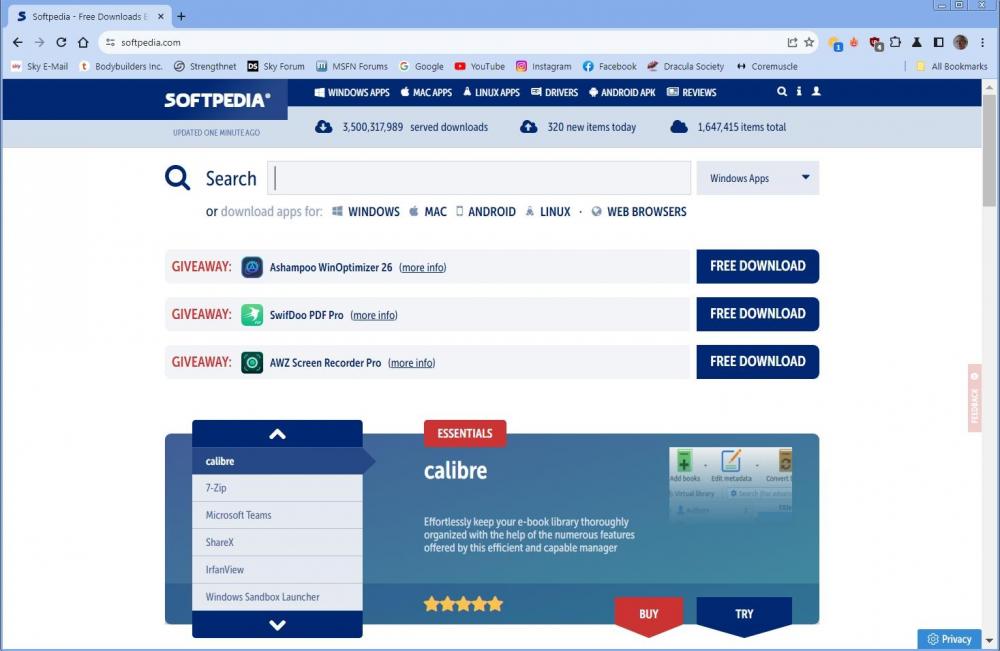Content Type
Profiles
Forums
Events
Everything posted by Dave-H
-
Just an update on the font problem at forums.digitalspy.com when Thorium and Supermium were used on Windows XP. It has been fixed in Supermium 126, so hopefully it will be fixed in the next update to Thorium Legacy too.
-
-
Just an update. I have now indeed uninstalled Google Chrome from Windows 10, and I've installed Supermium 126 x64 instead, as the default browser. It works fine, and I've now got uBlock Origin back again! I've also updated my Supermium x86 installation on XP to version 126, all good. I'm still using Thorium 122 as the default browser on XP.
-
Thanks, I might play with those later. I'm not actually too worried about this, it doesn't make the sites unusable. Now I know why it's happening I can live with it, I was just puzzled as to why things had changed, now I know! It appears that I could go back to using uBlock Origin on Thorium and Supermium, but that might cause issues with the syncing of extensions with Google Chrome on my Windows 10, where I'm soon going to have to use uBlock Origin Lite, but I'll see how it goes. I know I can disable the syncing of extensions, but I actually think it's a useful feature.
-
... Oops dear Dave , isn't that a contradiction of sorts? Not really, as when I posted the first quote I hadn't been told by @Sampei.Nihira about the way that uBlock Origin Lite works, which gave me the clue as to what was actually happening. I hadn't made the connection until then.
-
I just did! Strangely, CPU-Z 2.09 on XP isn't prompting me that there's an update. I don't know if that is significant or not.
-
Thank you, that's probably the problem! I had to turn uBlock Origin Lite up to maximum filtering on Facebook and Instagram as otherwise the endless annoying 'sponsored posts' still get through. Looks like I'll just have to live with it as it is.
-
No difference with the switch added on my XP system. Still eating RAM, and then the tab process crashes.
-
@Dixel Thanks, I've added the '--enable-low-end-device' switch. I'll report back as to whether it helps or not. @Sampei.Nihira Thanks, but I've stopped using uBlock Origin, and I'm now using uBlock Origin Lite. uBlock Origin is going to be blocked on Chromium browsers soon, isn't it?
-
My copy of Thorium has now started running out of memory when scrolling on sites like Facebook and Instagram. It didn't use to do this, it was much better than Supermium in that respect, and it's been fine for months. Anyone any idea why it would suddenly start doing this, I haven't knowingly changed anything which might have caused it? Of course, the sites themselves may have changed, but any changes made haven't caused any obvious visual changes in them.
-

[TOOL] POWIS - Powerful Windows Setup v1.0.3
Dave-H replied to George King's topic in Unattended Windows 10/11 Installation
I suggest you use the 'ignore' button, that's what it's there for.- 23 replies
-
- driverpacks
- unattended
-
(and 3 more)
Tagged with:
-

[TOOL] POWIS - Powerful Windows Setup v1.0.3
Dave-H replied to George King's topic in Unattended Windows 10/11 Installation
@George King With respect, we should try to engage with fellow members here, not just have their content suppressed. I hope you can address @archlinuxuser's issues, by PM if necessary. If you can't, I will address this with them.- 23 replies
-
- driverpacks
- unattended
-
(and 3 more)
Tagged with:
-

Ublock Origin Lite (MV3) vs AdGuard MV3 Chromium Extensions
Dave-H replied to a topic in Web Browsers
Thank you! -

Ublock Origin Lite (MV3) vs AdGuard MV3 Chromium Extensions
Dave-H replied to a topic in Web Browsers
FWIW, I'm now using uBlock Origin Lite on Thorium and Supermium on XP, and Google Chrome 127 on Windows 10. Like a huge number of people, I always loved uBlock Origin, but it will be disabled on Chrome soon, as we all know. The Lite version seems to work fine, and blocks as many ads as the full version, as far as I can see. My one regret is that it doesn't have the function to block elements in a page, so I'm now having to let through a few banners and the like which I used to block. I think I can live with that though. Going back to Firefox isn't really an option for me, as there is no Firefox equivalent browser for XP which will sync with Firefox on Windows 10 and my phone. (I have to use Firefox on my phone as Android Chrome does not allow extensions, and using a browser with no blocker is an absolute no-no as far as I'm concerned!) -
Sorry for the delay, still been working on this! The trial version of Resource Tuner fixed the icons, thanks very much. I think I now have everything configured as it should be. Thorium is the default browser on XP, and seems to be performing fine.
-
I thought DefaultBrowser 1.8 was a good program too, I mentioned that the single click undo button particularly was good. Unfortunately, it didn't sort out my particular problem. Thanks for the information about the loader file, that explains it! I will try to do it with the latest Resource Hacker in Windows 10.
-
I did try DefaultBrowser 1.8, I reported back here that it didn't fix the problem. I've just spent the whole afternoon trying to track this problem down by process of elimination, which was very tedious! Finally, I've determined that it's due to the ancient 16 bit 'Run' program that I use as a program launcher. I never managed to get Thorium to run from it, and now I know why! 360Chrome won't run from it directly, but it will run from it using Launcher.exe to run its shortcut, but that doesn't work with Thorium. I have two 16 bit programs running on XP, the 'Run' program launcher, and an on-screen clock. I discovered that if they weren't launched, the problem went away and links from e-mails launched fine in Thorium. Running them brought the problem back. It now appears that I can run them, but the links only work from my e-mail program if I don't run it from the launcher. Running it from the launcher, which I've been doing for years, appears OK, but links then crash Thorium. Why this is happening, I have absolutely no idea! Just as an aside, how did you change the icon in the Thorium launcher program? I've tried doing it with Resource Hacker, but it won't work. I can replace the resource, but I can't then compile it or save it, everything is greyed out. Making other changes are fine, but not changing the icon.
-
Interesting conversation here since I last posted! My problem getting Thorium and Supermium to run correctly from links in documents is not resolved, but my great thanks go to @rereser who has given me an enormous amount of help with this via PM. The associated registry entries relevant to this were in a bit of a mess on my system, to put it mildly, but I think they are as they should be now! Two likely important things I have now determined. Firstly, the links are being passed correctly to Thorium, what is failing is the running of the browser from them. If I have Thorium already open, the links open in it perfectly, so that is a sort of workaround. I just have to remember to open Thorium first before I click on any links in e-mails! The other is that the problem goes away in Safe Mode. That to me would indicate that it's something that's running on the system which is causing the issue. I've already (I hope) eliminated Malwarebytes from blame, as the problem still happens with it shut down. In light of the previous conversation, I'm now scouring my System32\Drivers folders for unwanted obsolete driver files! Nothing found yet. I will carry on experimenting.
-
OK, back again, but no good news to report I'm afraid. I cleaned the registry of all the Thorium references, and then made Google Chrome 49 my default browser. It worked perfectly, opening HTM(L) files from Windows Explorer, and also opening links in documents correctly (apart from the intrinsic problems caused by its age of course). I then changed the path in HKEY_CLASSES_ROOT\https\shell\open\command to point to ThoriumLoader.exe instead of Chrome.exe (I have changed the name of the file again to match AstroSkipper's chosen name). No joy, Thorium still opened incorrectly. I then wondered if perhaps, as I hadn't installed Thorium in its default folder, maybe it didn't like that for some reason. So, I completely removed Thorium except for its User Data folder (I'm not setting all that up again if I can help it!) and re-installed it using its installation CMD file. This worked fine, I changed the paths in the loader INI file, and all was well, except that it still wouldn't open links correctly. I am going to leave its location as it is now. I then tried the same thing with Supermium, and I'm sure you won't be surprised to hear that it has exactly the same problem! I tried removing Supermium (again apart from the User Data folder) and re-installed it using its installation file, which I'd not actually used before. Again, it's working fine, but will not load links correctly. My finger of suspicion then moved to Malwarebytes Premium, as that has caused strange effects with some programs in the past due to its 'hardening' functions. Not guilty this time, the problem is still there with it not running. So, what now, this is a complete mystery to me. I guess I could ask the developers of Thorium and Supermium if they know what's happening here. Could someone else try this, putting a command line to run Thorium in HKEY_CLASSES_ROOT\https\shell\open\command and see if it works for you, on XP of course?
-
FWIW, it's always worked fine for me. I get a lot of pops and clicks, but that's expected. Volume I can adjust using WaveOut.exe. I have no sound in DOS games, but that's not a problem for me. There is no recording functionality, but I would have been really amazed if there had been! I've never had any system hangs which were knowingly due to the audio driver.
-
Thanks, it will be in a while now, but I will report back!
-
Thanks, I'll bear that in mind! I was just thinking that making another Chromium browser the default, even a very old one, would be a better starting point than doing it with Internet Explorer.
-
Thanks. What I was thinking of doing, as I still have Google Chrome 49 installed on the XP system, and it does have the mechanism to make it the default browser, is to try making that the default browser temporarily, check that works properly with links, and then go through the registry changing all of its entries to point to Thorium instead. Does that sound like a plan?


